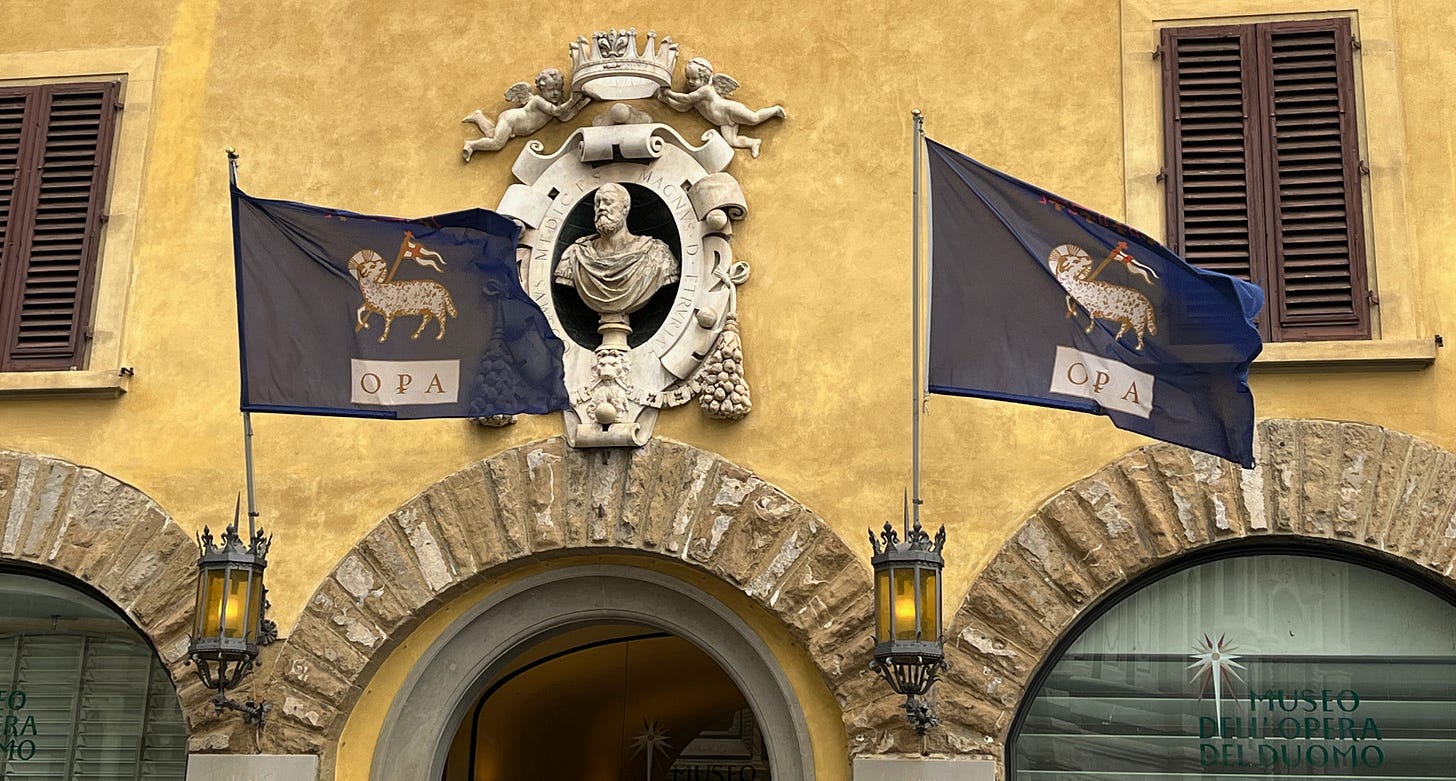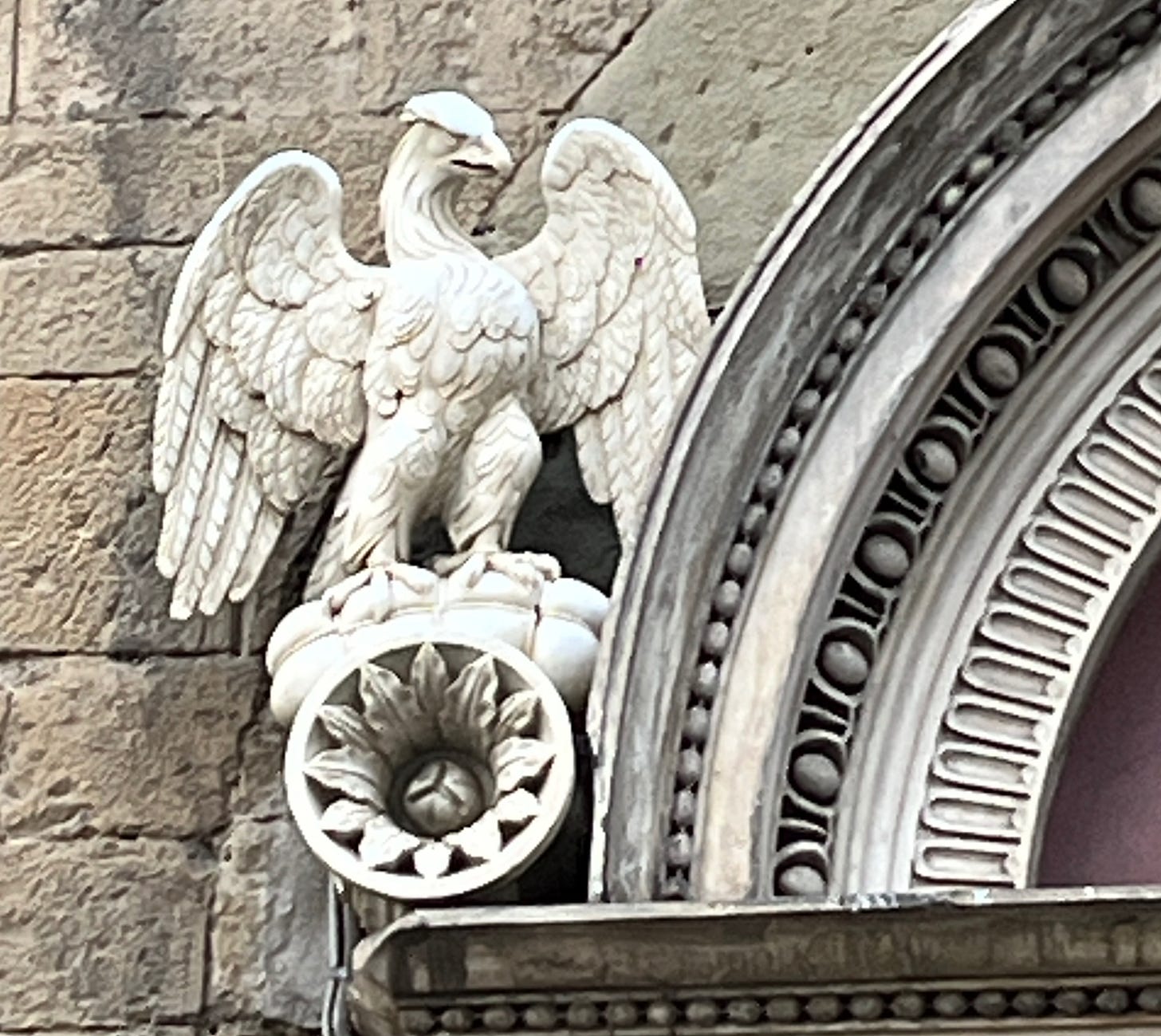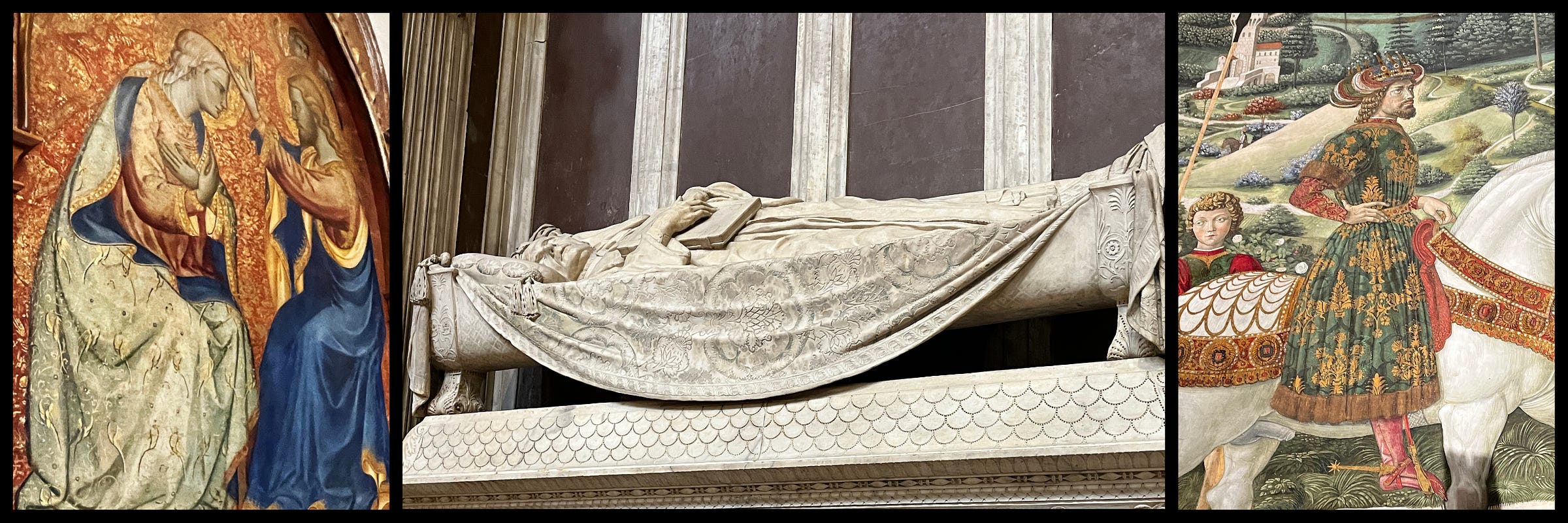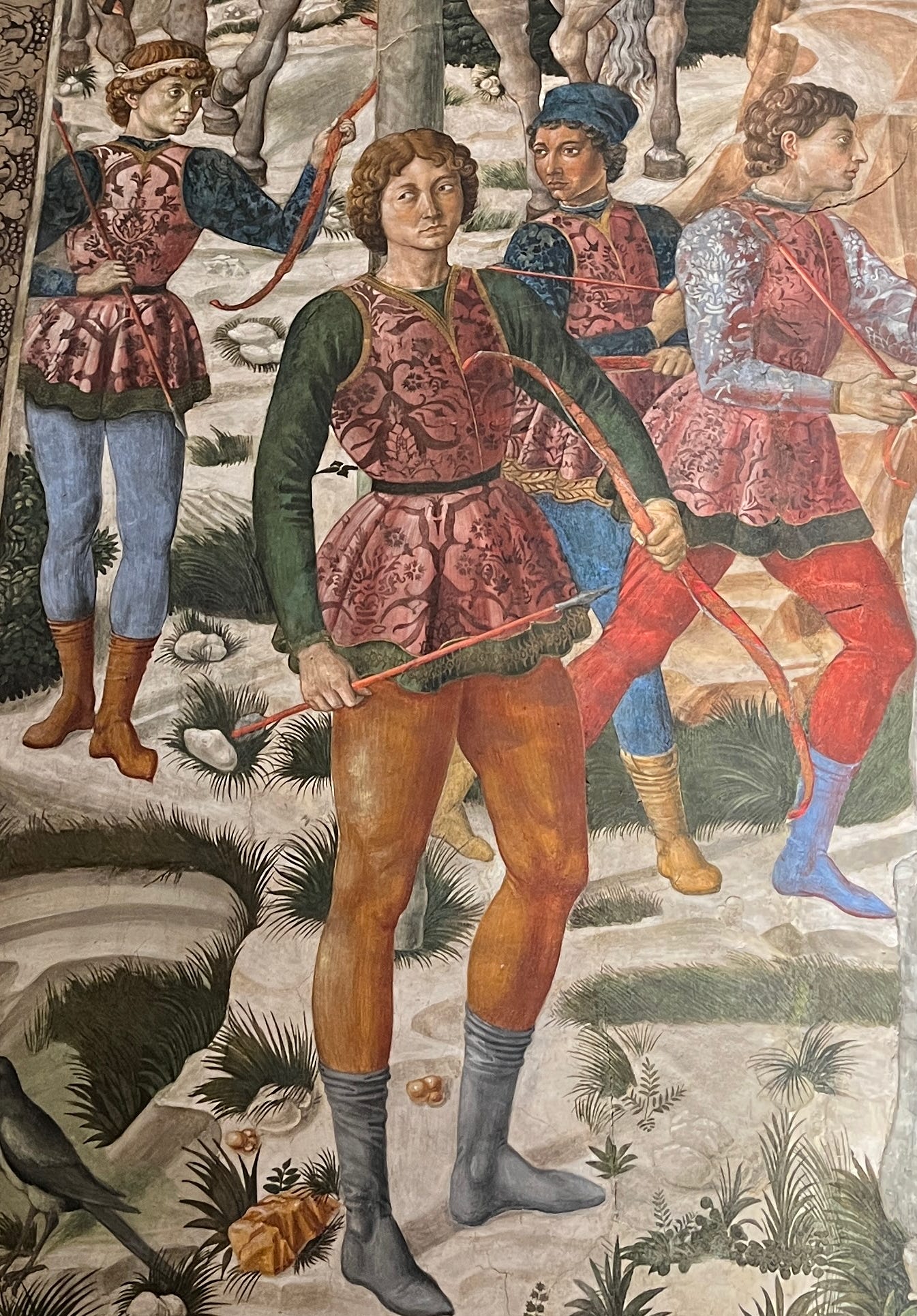Traces of Textiles in Florence

The textile trade, including the banking institutions that it fostered, made Florence rich. The production, finishing, and sale of cloth funded the art that now supports the city’s tourist industry. Its greatest single artwork may be famously nude, but traces of the central role of textiles are everywhere in Florence.
Take the street names: Via de’Vellutini and Canto de Velluti refer to velvets. Calimaruzza and Calimala are named for the guild that finished and sold foreign cloth, such as English woolens, while the Via Dell’Arte della Lana is named for the wool guild. Its symbol of the Lamb of God with a banner is everywhere—a seemingly religious sign that is as much a commercial brand as an Apple with a bite out of it.
The Calimala is slightly less subtle, with an eagle on a bolt of cloth.
The city’s luxurious silks mostly show up in paintings. Art historian Rembrandt Duits argues that the abundant gold brocades represent in cheaper paint what even the wealthiest Florentines couldn’t afford in real life.
Even without the gold, weaving such complex patterns was incredibly time-consuming and labor-intensive before Jean-Marie Jacquard’s famous punchcard system automated them at the turn of the 19th century. If you visit a still-existing workshop like the Antico Setificio Fiorentino in Florence or Tessitura Luigi Bevilacqua in Venice, you will see what now looks like a laborious process. But it’s actually speedy and high-tech. These artisans use Jacquard looms, which can be operated by a single weaver, without an assistant to lift pattern threads. Coded into cards, the patterns can also be stored and reused. Here’s an 18th-century depiction of a European draw loom, with figures showing the weaver and the “draw boy (or girl)” who pulled the pattern threads. Every single pass across the loom required a different selection of threads, and the setup was new for each new pattern. (For more details see chapter three of The Fabric of Civilization.)
Having written about Florentine sumptuary laws, I was also amused to see the mini-tunics, or pannos curtos (“short cloths”), that revealed men’s legs above the middle of the thigh when standing. Under a law passed in 1373, such sexy styles were prohibited unless the wearer paid a fine/fee of 10 florins. They were still in evidence decades later. Aside from showing off men’s muscled legs, they economized on expensive cloth, surely saving more than the value of the fine.
On a sadder note
My father died recently, after a rapid decline into dementia and a period of failing physical health that began with a fall in December. Unlike many women, I have been blessed to be surrounded all my life by good men, starting with Daddy and including my three brothers and later Steven. My father believed I could do anything, and he adored my mother, his own mother, and his big sister. Traditional in many respects, he never doubted the capability of women. Here are my favorite photos of Daddy and me together, the first when I was about two and the second on my book tour for The Future and Its Enemies.
With a few contributions from the rest of us, my brother Sam wrote a terrific obituary:
A devoted husband, father, preacher’s son, brother, uncle, mentor, coach, raconteur, trouble-shooter, carpenter, repairman, friend, and church leader, Samuel Martin Inman, III, age 88, passed away May 15, 2023, of old age: a venerable way to exit this modern era and begin a refreshed life with his Lord.
The Reverend Samuel M. Inman and Margaret Garwood Inman raised Sam and his older and surviving sister Margaret first in Richmond, Virginia, and then in Charlotte, North Carolina. Following his being among the first class to graduate the new Myers Park High School, Sam played tennis for Davidson College and graduated in 1956, having majored in mathematics and minored in physics. Within 18 months thereafter, Sam also graduated with an industrial engineering degree from the Georgia Institute of Technology (Georgia Tech). During his time in Atlanta, Sam found a focus of his love and attention for the next 67 years: the outgoing, intelligent, transplanted Arkansas Presbyterian Sue Sanders Lile, whom he married in 1958. As he began his career in the newfangled field of commercial plastics, he also served in the United States Army Reserves for 6 ½ years, with a year of active duty at Fort Benning, Georgia, during the Berlin and Cuban Missile Crises.
Sam worked for Celanese Corporation in Rome, Georgia, followed by a transfer with the company to Greenville, where he was a part of the design team that built the Greer (SC) Celanese Polyester Films Plant. Over the course of his professional career, Sam became the manufacturer’s go-to guy in solving problems in production, quality control, research and development, and technical service. In 1992, the successor to Celanese — Hoechst Diafoil — sent him and Sue to Japan, where he spent a year as liaison representative for the joint plastics venture that included operations in Germany (Hoechst AG), the USA (Celanese), and Japan (Mitsubishi Diafoil). A Japanese colleague dubbed him “Mr. Polyester,” which we think was a supreme compliment.
Active in Greenville’s Westminster Presbyterian Church since 1963, Sam served as an elder, deacon, Sunday school teacher, youth advisor, basketball coach, and a member of a pulpit nominating committee. For several years, he taught in the “Life Skills” program at United Ministries as part of the pre-GED Program. He served as chairman of the chemistry advisory committee at Greenville Technical College, chairman of the Presbyterian Pastoral Counseling Center, advisor to the Foothills Presbytery for various church strategies and operations, and as a board member and a lead carpenter for The Warehouse Theater. And in his “spare time,” he co-coached youth baseball teams with the YMCA and City League to multiple undefeated seasons.
His passions were rooted in his energetic church and dynamic family, both now spread like a proverbial banyan tree that his father often used in parable. Sam loved walking in the woods, whether in northern Georgia, the two Carolinas, or the West. He loved American history, especially of the Southeast, and was known to breeze through and retain the thoughts and facts of the thickest historical novels that The Open Book stores in Greenville could offer.
Sam is survived by his wife of 64 years, Sue Lile Inman, and their adult children and spouses: Virginia and Steven Postrel, Los Angeles; Sam and Jamie Inman, Greenville, SC; Drs. John and Amy Inman, Mt. Pleasant, SC; and Bill and Karen Inman, Bend, OR. His four treasured grandchildren – Rachel, Nathan, Andrew, and Katherine – also survive him.
A memorial service will be held at Westminster Presbyterian Church on Saturday, June 17, 2023, at 12:00 p.m., followed by a reception in the church atrium.
Memorials may be made to Westminster Presbyterian Church Endowment Fund, 2310 Augusta Street, Greenville, SC 29605, www.wpc-online.org; United Ministries, 606 Pendleton Street, Greenville, SC 29601, www.unitedministries.org; or a charity of one’s choice.






